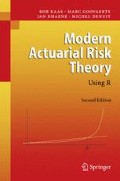In this chapter we focus on the distribution function of the total claim amount S for the portfolio of an insurer. We are not merely interested in the expected value and the variance of the insurer’s random capital, but we also want to know the probability that the amounts paid exceed a fixed threshold. The distribution of the total claim amount S is also necessary to be able to apply the utility theory of the previous chapter. To determine the value-at-risk at, say, the 99.5% level, we need also good approximations for the inverse of the cdf, especially in the far tail. In this chapter we deal with models that still recognize the individual, usually different, policies. As is done often in non-life insurance mathematics, the time aspect will be ignored. This aspect is nevertheless important in disability and long term care insurance. For this reason, these types of insurance are sometimes considered life insurances.
In the insurance practice, risks usually cannot be modeled by purely discrete random variables, nor by purely continuous random variables. For example, in liability insurance a whole range of positive amounts can be paid out, each of them with a very small probability. There are two exceptions: the probability of having no claim, that is, claim size 0, is quite large, and the probability of a claim size that equals the maximum sum insured, implying a loss exceeding that threshold, is also not negligible. For expectations of such mixed random variables, we use the Riemann-Stieltjes integral as a notation, without going too deeply into its mathematical aspects. A simple and flexible model that produces random variables of this type is a mixture model, also called an ‘urn-of-urns’ model. Depending on the outcome of one drawing, resulting in one of the events ‘no claim or maximum claim’ or ‘other claim’, a second drawing is done from either a discrete distribution, producing zero or the maximal claim amount, or a continuous distribution. In the sequel, we present some examples of mixed models for the claim amount per policy.
Access this chapter
Tax calculation will be finalised at checkout
Purchases are for personal use only
Preview
Unable to display preview. Download preview PDF.
Rights and permissions
Copyright information
© 2008 Springer-Verlag Berlin Heidelberg
About this chapter
Cite this chapter
(2008). The individual risk model. In: Modern Actuarial Risk Theory. Springer, Berlin, Heidelberg. https://doi.org/10.1007/978-3-540-70998-5_2
Download citation
DOI: https://doi.org/10.1007/978-3-540-70998-5_2
Publisher Name: Springer, Berlin, Heidelberg
Print ISBN: 978-3-540-70992-3
Online ISBN: 978-3-540-70998-5
eBook Packages: Business and EconomicsEconomics and Finance (R0)

